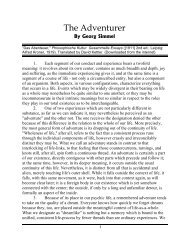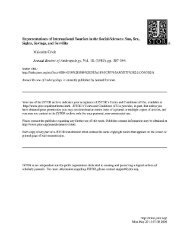The Maya Uay K'ot - OSEA-CITE
The Maya Uay K'ot - OSEA-CITE
The Maya Uay K'ot - OSEA-CITE
Create successful ePaper yourself
Turn your PDF publications into a flip-book with our unique Google optimized e-Paper software.
course that serving a meal will bring money and that house rent be paid by one who is<br />
given lodging” (1950: 65). In any case, by 1948 Chan Kom had four well-stocked general<br />
stores whereas in 1931 it only had one, and, as Redfield himself notes, the “uayes were ...<br />
real” (1950: 125).<br />
Not surprisingly, perhaps, the state and its various dependencies were behind<br />
many of these activities. As Ben Fallow notes, Yucatán’s socialist governor, Bartolomé<br />
Garcia Correa (1930-33), was intent on modernizing the <strong>Maya</strong> by spreading “western<br />
models of labor, consumption and recreation” (1997: 558). In addition to promoting<br />
baseball, good hygiene and consumer items that went along with it (e.g., shoes, new<br />
clothing), the Garcia Correa administration held female beauty pageants and male strong<br />
man contests “to reward the most ‘hardworking’ and ‘progressive’ males; winners were<br />
crowned ‘India bonita’ and ‘Indio robusto’” (1997:558). A similar proposal was put forth<br />
by Humberto Peniche Vallado, a prominent Yucatecan educator, on the eve of the<br />
Cárdenas agrarian reform in 1935. For Peniche Vallado the problem was not simply that<br />
the <strong>Maya</strong> had grown averse to physical and mental labor but that they lacked the<br />
sentiments and “bodily needs” that linked other subjects to the world of comodidades<br />
(understood both as comforts and commodities). For agrarian reform to succeed the <strong>Maya</strong><br />
villager would first have to be transformed into a subject of irrepressible desires (In<br />
Cetina Sierra et. al., 1987: 95).<br />
<strong>The</strong> problem – to my understanding – does not lie precisely in learning how to<br />
read or acquiring a certain level of knowledge. <strong>The</strong> problem lies in elevating [the<br />
Indian’s] standard of living, in making sure that he enjoys the well-being that<br />
civilization has brought, and in creating bodily needs (necesidades) for him<br />
[Translated from original by author].<br />
To release the elemental passion of the Indian, emotions repressed by centuries of<br />
exploitation, Peniche Vallado proposed a curriculum which emphasized competitive<br />
sports, theatre and excursions throughout the state. Although in his opinion baseball and<br />
tennis might prove too intellectually demanding, other competitive activities such as<br />
track, weightlifting and wrestling would elevate the Indian’s spirit and enable him to<br />
overcome his “inferiority complex” (In Cetina Sierra et. al. 1987: 104).<br />
More importantly, though, it was the responsibility of the rural educator to make<br />
modernity enchant by embedding the consumption of new commodities in community<br />
events where emotions ran high. In particular, Peniche Vallado recommended that<br />
teachers induce villagers to construct a hygienic, cinder block house with all the latest<br />
amenities: running water, a cement floor, etc., and in an opportune moment invested with<br />
all the pomp and gaiety of the annual fiesta, to raffle off the exemplary construction.<br />
Similarly, patriotic holidays and the emerging courtship ritual provided excellent<br />
opportunities to help students form an affection for good clothes. While Peniche Vallado<br />
was against imposing western dress on young students, the demands of courtship<br />
combined with the “capricious” nature of women would, in his view, make the<br />
introduction of modern apparel much easier. In short, through rituals old and new – what<br />
Sydney Mintz (1985: 122) refers to as “rituals of intensification” – the elementary school<br />
teacher would gradually develop the student’s aesthetic sensitivity and self-discipline,<br />
qualities which would not only induce the <strong>Maya</strong> to covet personal property but were<br />
considered the building blocks of civilization itself.<br />
12




